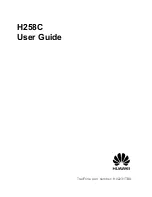
3-48
Theory of Operation
: Bluetooth
3.5
Bluetooth
The Bluetooth feature allows the radio the ability to connect wirelessly to a Bluetooth accessory or
data terminal. This feature is implemented using a combination of Bluetooth/GPS integrated circuit
(IC, U1301), a low-frequency receiver (NFC, U2403), and a host controller (U2415) with external 128
MB SDRAM (U2413). The Bluetooth IC sends data to the host controller processor over an HCI
USART link. The host controller processor communicates to the OMAP processor on the RF board
through a dedicated USB port.
Each APX accessory that is capable of Bluetooth communication will have its own unique Bluetooth
address. An external audio accessory headset can establish a digital connection using a low-data
rate GFSK modulated signal hopping on 79 x 1 MHz wide Bluetooth channels from 2402 MHz to
2480 MHz in the ISM band. Bluetooth uses a frequency hopping spread spectrum (FHSS) technique
to spread the RF power across the spectrum to reduce the interference and spectral power density.
The frequency hopping allows the channel to change up to 1600 times a second (625 us time slot)
based on a pseudo random sequence. If a packet is not received on one channel, the packet will be
retransmitted on another channel.
The Bluetooth feature is accompanied by a Low-Frequency (LF) detection circuit. Once a radio has
the Bluetooth feature enabled, a user can tap their LF enabled Bluetooth audio accessory with the
radio at the pairing spot to establish a secure Bluetooth connection. The LF circuit provides the
ability of a secure pairing connection with a Bluetooth accessory by sending secure messages
including the BT address of the external accessory during pairing. The LF circuit uses a 125 kHz
signal to communicate the secure pairing information over a dedicated SPI bus between the
Bluetooth accessory and the AVR32 processor.
Low-frequency transmission is done by the host controller itself using a NOR gate. The LF antenna
is located on the radio’s back housing with a blue dot marking. The antenna is connected to the LF
receiver IC on the mainboard via a flex. The Bluetooth antenna is a stamped metal folded monopole
antenna mounted on the radio’s front housing:
Figure 3-36. Relation of Bluetooth & LF Antenna Assembly to Main Board
= Main Flex
= NFC Flex
KEY
Front
Housing
with
BT Antenna
Main Board
(NL5500)
LF
Antenna
Summary of Contents for Astro APX 3000
Page 1: ...APXTM TWO WAY RADIOS APX 3000 DETAILED SERVICE MANUAL ...
Page 2: ......
Page 4: ...Notes ...
Page 6: ...vi Document History Notes ...
Page 10: ...x Table of Contents Notes ...
Page 12: ...xii List of Tables Notes ...
Page 18: ...xviii List of Figures Notes ...
Page 22: ...xxii CommercialWarranty Notes ...
Page 46: ...3 20 Theory of Operation Main Board Notes ...
Page 84: ...3 58 Theory of Operation Bluetooth Notes ...
Page 208: ...6 64 Troubleshooting Waveforms LF CW on Spectrum Analyzer Notes ...
Page 222: ...7 14 Troubleshooting Tables List of Board and IC Signals Notes ...
Page 282: ...8 60 Schematics Boards Overlays and Parts Lists Main Board Block UHF1 84012513001_A Notes ...
Page 390: ...8 168 Schematics Boards Overlays and Parts Lists Main Board Block VHF 84012512001_A Notes ...
Page 456: ...9 8 Debugging Fixture Powering up Covert Board Notes ...
Page 468: ...Glossary 10 Glossary Notes ...
Page 472: ...Index 4 Index Notes ...
Page 473: ......
















































